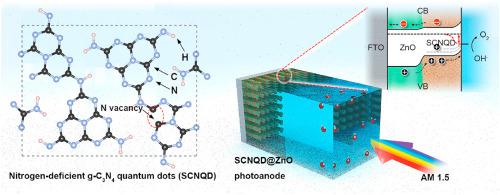Our official English website, www.x-mol.net, welcomes your feedback! (Note: you will need to create a separate account there.)
Molten-based defect engineering polymeric carbon nitride quantum dots with enhanced hole extraction: an efficient photoelectrochemical cell for water oxidation
Carbon ( IF 10.9 ) Pub Date : 2021-03-01 , DOI: 10.1016/j.carbon.2020.11.032 Wenyao Zhang , Maiwen Zhang , Wenwen Liu , Aiping Yu
Carbon ( IF 10.9 ) Pub Date : 2021-03-01 , DOI: 10.1016/j.carbon.2020.11.032 Wenyao Zhang , Maiwen Zhang , Wenwen Liu , Aiping Yu

|
Abstract Polymeric carbon nitride (g-C3N4) has emerged as a promising material for energy-related applications. However, the utilization of g-C3N4 in photoelectrochemical cells is still limited by poor exciton mobility, sluggish hole extraction, and short electron diffusion length. Here, we report a molten-based defect engineering strategy to prepare nitrogen-deficient g-C3N4 quantum dots (SxCNQD) for photoelectrochemical water splitting. This novel strategy requires no chemical etching or secondary treatments like recent state-of-the-art defect introduction methods, and for the first time achieves the in-situ integration of nitrogen-vacancy defects (NVs) during the polymerization of g-C3N4. Theoretical evaluation and experimental validation identified that the involved structural NVs redistribute the electrons on the delocalized π-conjugated networks of g-C3N4 and creates an additional sub-band on the optical bandgap, which can effectively improve carrier separation, facilitate charge transport dynamics, and boost hole extraction. Beneficial from its featured topological structures and electronic properties, the S600CNQD@ZnO photoanode exhibits a markedly high photocurrent density of 193.8 μA cm−2 at 1.23 V vs. RHE, long-term durability, as well as an impressive IPCE value in an alkaline solution in the absence of sacrificial agent under visible light illumination.
中文翻译:

具有增强空穴提取的基于熔体的缺陷工程聚合氮化碳量子点:一种用于水氧化的高效光电化学电池
摘要 聚合氮化碳 (g-C3N4) 已成为能源相关应用的一种有前途的材料。然而,g-C3N4在光电化学电池中的利用仍然受到激子迁移率差、空穴提取缓慢和电子扩散长度短的限制。在这里,我们报告了一种基于熔融的缺陷工程策略,以制备用于光电化学水分解的缺氮 g-C3N4 量子点 (SxCNQD)。这种新颖的策略不需要化学蚀刻或二次处理,如最近最先进的缺陷引入方法,并且首次在 g-C3N4 聚合过程中实现了氮空位缺陷 (NVs) 的原位集成。理论评估和实验验证表明,所涉及的结构 NV 重新分配了 g-C3N4 离域 π 共轭网络上的电子,并在光学带隙上创建了一个额外的子带,这可以有效改善载流子分离,促进电荷传输动力学,并且增强孔提取。S600CNQD@ZnO 光阳极得益于其独特的拓扑结构和电子特性,在 1.23 V vs. RHE 下具有 193.8 μA cm-2 的显着高光电流密度、长期耐用性以及在碱性溶液中令人印象深刻的 IPCE 值在可见光照射下不存在牺牲剂。并促进孔提取。S600CNQD@ZnO 光阳极得益于其独特的拓扑结构和电子特性,在 1.23 V vs. RHE 下具有 193.8 μA cm-2 的显着高光电流密度、长期耐用性以及在碱性溶液中令人印象深刻的 IPCE 值在可见光照射下不存在牺牲剂。并促进孔提取。S600CNQD@ZnO 光阳极得益于其独特的拓扑结构和电子特性,在 1.23 V vs. RHE 下具有 193.8 μA cm-2 的显着高光电流密度、长期耐用性以及在碱性溶液中令人印象深刻的 IPCE 值在可见光照射下不存在牺牲剂。
更新日期:2021-03-01
中文翻译:

具有增强空穴提取的基于熔体的缺陷工程聚合氮化碳量子点:一种用于水氧化的高效光电化学电池
摘要 聚合氮化碳 (g-C3N4) 已成为能源相关应用的一种有前途的材料。然而,g-C3N4在光电化学电池中的利用仍然受到激子迁移率差、空穴提取缓慢和电子扩散长度短的限制。在这里,我们报告了一种基于熔融的缺陷工程策略,以制备用于光电化学水分解的缺氮 g-C3N4 量子点 (SxCNQD)。这种新颖的策略不需要化学蚀刻或二次处理,如最近最先进的缺陷引入方法,并且首次在 g-C3N4 聚合过程中实现了氮空位缺陷 (NVs) 的原位集成。理论评估和实验验证表明,所涉及的结构 NV 重新分配了 g-C3N4 离域 π 共轭网络上的电子,并在光学带隙上创建了一个额外的子带,这可以有效改善载流子分离,促进电荷传输动力学,并且增强孔提取。S600CNQD@ZnO 光阳极得益于其独特的拓扑结构和电子特性,在 1.23 V vs. RHE 下具有 193.8 μA cm-2 的显着高光电流密度、长期耐用性以及在碱性溶液中令人印象深刻的 IPCE 值在可见光照射下不存在牺牲剂。并促进孔提取。S600CNQD@ZnO 光阳极得益于其独特的拓扑结构和电子特性,在 1.23 V vs. RHE 下具有 193.8 μA cm-2 的显着高光电流密度、长期耐用性以及在碱性溶液中令人印象深刻的 IPCE 值在可见光照射下不存在牺牲剂。并促进孔提取。S600CNQD@ZnO 光阳极得益于其独特的拓扑结构和电子特性,在 1.23 V vs. RHE 下具有 193.8 μA cm-2 的显着高光电流密度、长期耐用性以及在碱性溶液中令人印象深刻的 IPCE 值在可见光照射下不存在牺牲剂。


























 京公网安备 11010802027423号
京公网安备 11010802027423号